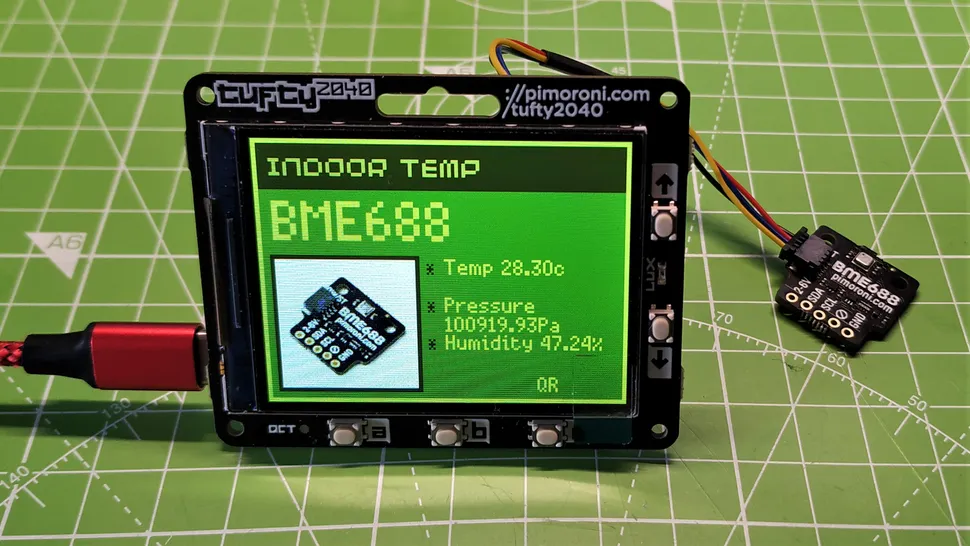Review Pimoroni Tufty 2040
Static conference badges made of paper or plastic are from the 20th century. Today, enterprising manufacturers can choose from a variety of microcontroller and screen combinations and program them to display what they need. The Raspberry Pi's RP2040 chip is the perfect processor for these interactive badges. Pimoroni's latest RP2040-equipped board, the Tufty 2040, replaces the 2.9-inch e-paper screen we saw on the company's Badger 2040 with a full-color 2.4-inch IPS display.
The Tufty 2040 is more than just a wearable display with the power of Pi Silicon behind it. It also functions as an iOT device, allowing you to view sensor outputs, photos, etc. from a comfortable desk. The Toughty 2040 is one of the best RP2040 boards you can buy. The only major flaw in the Tufty 2040 is the lack of an official chassis. This led to the design of a unique 3D printing case for storing it and a LiPo battery that is safe all day long at meetings.
| SoC | RP2040 (Dual Arm Cortex M0+ running at up to 133 Mhz with 264kB of SRAM) |
| Display | 2.4 Inch ST7789v Color IPS LCD display (320 x 240 pixels) |
| Storage | 8MB of QSPI flash supporting XiP |
| GPIO | Five user buttons |
| Phototransistor (light sensor) | |
| Qw/ST (Qwiic / Stemma QT) connector | |
| I2C, UART, SWD breakouts | |
| Power | USB C (Data and power) |
| JST-PH connector (3-5.5V) via 3 x AAA or LiPo | |
| Dimensions | 65.20 x 52.70 mm |
Using Tufty 2040
We tested the Integrated QW / ST connector, a Portmanteau from the SEMMA QT Stemma QT connector from Sparkfun and Adafruit. QW / ST is essentially just an I2C connection that works with compatible compatible cards.
We tested Tufty 2040 with a BME688 temperature sensor. We obtained the current temperature, air pressure and humidity data, then changed the example of retro badge to display this data. It didn't take long for it to work, and it increases this by being a simple badge, in a small -scale data collection and display device, all wrapped in a neat package with an excellent screen.
If a sensor is compatible with Micropython and the Raspberry Pi Pico, it can be used with Tufty 2040. Pimoroni has a selection of modules and examples of micropython which can be easily used. If your sensor is not listed, you can use Pypi and the Python community to find an alternative module.
This leads us to the management of circuitpython. In the current state of things, there is no custom circuitthon version for tufty 2040. You can install the firmware Raspberry Pi Pico, but at the moment, the support of the ST7789 screen is not available. As a rule, this screen uses SPI as an interface, but for Tufty 2040, it is connected via a parallel bus. So for the moment, the CircuitPython support is not entirely equally with Micropython.
The onboard JST-PH connector is for use with 3 x AAA batteries, or a LiPo battery. Tufty 2040 has no inbuilt charging circuit for LiPo so you will need to use a battery charger such as a TP4056 or Pimoroni’s LiPo Amigo. We used a LiPo Amigo to charge a 1,000 mAh LiPo battery. This battery lasted for a full five hours of use at our maker event, and it even had a few more hours to give once we got home. Your mileage may vary, depending on how hard Tufty 2040 is worked.
Who is Tufty 2040 for?
The target market are the makers / creators who want to elevate their conference badge game from ePaper or LCD to IPS LCD. But this is not just a one trick pony. The Qw/ST connector opens up a world of sensors and add-ons that we can use to add extra functionality.
Our Tufty 2040 became an indoor sensor platform with relatively little work. Given a little more time and ingenuity a maker could really push Tufty 2040 to its limit, perhaps even a game of Doom?





